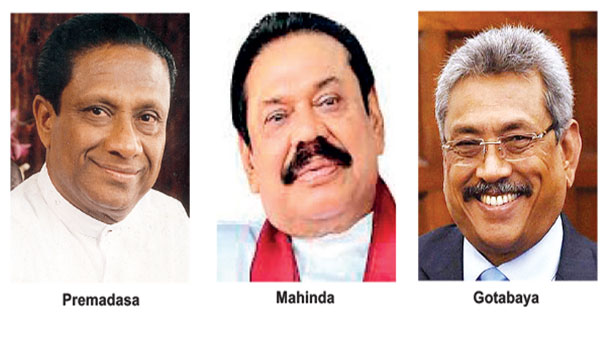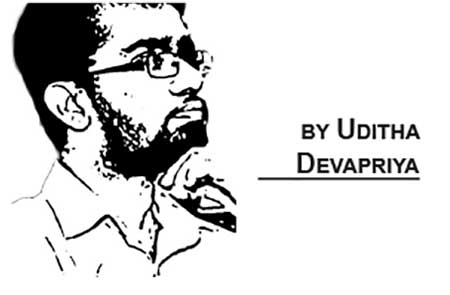Politics
A political history of post-1977 Sri Lanka

A crucial difference between Bonapartism and fascism is that the one responds to the public and the other regiments it. Bonapartism can deteriorate into fascism, as it not infrequently does, yet its populist-pluralist character deters it from doing so, unless its co-option by a right wing fringe group makes such a transformation inevitable.
There were three Bonapartist revolutions in post-Independence Sri Lanka. The first was Ranasinghe Premadasa’s election in 1988, the second Mahinda Rajapaksa’s election in 2005 and his re-election in 2010, and the third Gotabaya Rajapaksa’s election in 2019. I consider Premadasa, Mahinda, and Gotabaya as being more Bonapartist than fascist, contrary to most accounts of them by liberals and left-liberals.
What of the first Bonapartist revolution? Mervyn de Silva called the 1988 election, an event of sociological significance on account of its winner. Ranasinghe Premadasa has been called many things by many people. At the end of the day, regardless of whatever epithets, he was a Bonapartist tied, despite his populist trappings, to the Right. To say this is not to underrate his contribution: almost overnight, he oversaw an overhaul of J. R. Jayewardene’s economic policies without fundamentally deviating from them.
Foreign policy wise, Premadasa differed from Jayewardene’s pro-Western posturing. In 1977 Jayewardene had stated that his policy of non-alignment would be “more genuine” than what it had been under his predecessor. Two years later, however, the New York Times reported his famous quote about non-alignment, the US, and the Soviet Union. As K. M. de Silva and Howard Wriggins have noted in their JRJ biography, he was not a little reluctant to assume the role of the NAM’s chairmanship. His rapport with Fidel Castro at the 1979 NAM Conference in Havana, for all his theatrics, belied his tilt to the US.
Goh Chok Tong’s and Lee Kuan Yew’s visits to Sri Lanka reinforced the belief that Sri Lanka would resume its long anticipated journey to becoming the Singapore of South Asia, a prospect promised by the Mahaweli Development Scheme. This placed the country on the backbenches of the pro-Western bloc in the Non-Aligned Movement. Yet while Jayewardene courted European and American support, he was careful not to alienate the non-Western bloc. This explains his selection of A. C. S. Hameed as Foreign Minister.

It hardly need be added that after assuming the presidency, Premadasa took positions on foreign policy which contradicted some of Jayewardene’s, such as his expulsion of David Gladstone and his closure of the Israeli Special interests Section at the US Embassy; the latter act went as far as to provoke a confrontation with Stephen Solarz, who had been more favourably inclined towards his predecessor and had gone as far as proposing his name, and that of Rajiv Gandhi, for the Nobel Peace Prize vis-à-vis the Indo-Lanka Accord.
Back home, he courted considerable support among sections of the bourgeoisie as well as the petty bourgeoisie, including artists and the clergy (as seen in the latter’s act of siding him after Gamini Dissanayake and Lalith Athulathmudali campaigned against him). Yet in one respect he remained a part Bonapartist and not a total one: his inability to respond to the cultural critique of his political programme.
One should not be hasty in taking him to task over this, since with his assassination, his presidency became unfinished business. Nevertheless, unaddressed and unresolved, this critique widened a vacuum filled by the Jathika Chintanaya; I have attempted to chart the latter’s evolution from an intellectual to a political movement in a previous essay. All that needs to be noted here is that the absence of a political critique of neoliberalism during the Jayewardene and Premadasa presidencies helped consolidate a cultural critique of, not neoliberalism, but the idea of Western civilisation itself.
What helped such a critique gain even more ground was the capitulation of the Left to the neoliberal Right within the SLFP, and the dismantling of the state by the first Chandrika Kumaratunga government. The latter point is significant, for unlike J.R. and Premadasa, whose economic reforms required the centralisation of political power, Kumaratunga set about rolling back the state while opening up the economy.
As Dayan Jayatilleka has observed correctly, the co-option of the Kumaratunga regime by NGOs and the new “civil society” did much to provoke the nationalist lobby. Incensed, her nationalist supporters sought a third force. In the absence of a viable Left alternative – for Kumaratunga’s first term was marked by the deterioration of the Left within the People’s Alliance – nationalist critics of neoliberalism turned to the neoconservative right. Indeed, having decimated the Left within the SLFP, something not even three UNP administrations could do, Kumaratunga paved the way for a nationalist backlash.
In addition to strengthening the nationalist lobby, by axing or relegating to the background the Left faction of the SLFP, Kumaratunga not only moved her party to the neoliberal Right, she compelled the UNP to follow suit. Surprising as it may seem now, the UNP under Ranil Wickremesinghe at first opposed Kumaratunga over several sensitive issues, including her proposed Federal Package. In the second CBK presidency, however, the UNP did a volte-face on those same issues, not just moving to the right and embracing the gospel of peace at any price, but also abandoning its own Premadasa legacy.
In 2000, Dinesh Gunawardena’s Mahajana Eksath Peramuna joined the People’s Alliance. At the parliamentary election that year, he contested and retained his seat; he would do the same at elections the following year, becoming Minister for Transport and rescuing the SLTB from the neglect and squalor it had been reduced to by then.
Gunawardena’s ideology – an impeccable blend of socialism and popular nationalism, not unlike his father’s – provided an impetus to a revolt within the SLFP. That revolt culminated in 2004 when an overwhelming majority of the party stood behind Mahinda Rajapaksa’s bid as party candidate for the presidential election. Rajapaksa breathed life to Bonapartism in Sri Lankan politics thereafter, becoming an heir of sorts to Premadasa; not for no reason, after all, does Dayan Jayatilleka often compare the two with one another.
Where Rajapaksa differed from Premadasa was the acceptance he won among the Jathika Chintanaya ideologues and the Hela Urumaya MPs, as well as the Left (the Old Trotskyites, Communist plus the New JVP). Not that their objectives ever converged; the Hela Urumaya, for instance, sought a wider post-war political agenda than the Jathika Chintanaya, which set them on a collision course with the Left.
The firebrand of the JHU, Champika Ranawaka campaigned for Rajapaksa in 2005 and 2010 on the understanding that once they ended the war, they would enact reforms that would free the public sector from the inefficiencies and the culture of corruption which two and a half decades of untrammelled privatisation had pushed it to.
When he and Rajapaksa disagreed over the direction the latter took towards the end of his second presidency, Ranawaka not only had to leave the government, he had to leave it while being forced to shed his nationalist credentials. That says something about how Rajapaksa stole the nationalist light from its initial torchbearers.
Today Ranakawa is caught adrift: on the one hand the Sinhala nationalist crowd attacks him as a renegade, while on the other minority communities distrust him over his past. This was summed up at last year’s parliamentary polls: despite being given the No 1 preferential vote aboard the Samagi Jana Balavegaya in Colombo, Ranakawa came second from last to Mano Ganesan; the Sinhala middle bourgeoisie vote which he coveted went to the SLPP, while the SJB vote trifurcated between the Premadasa Central Colombo, Harsha de Silva’s suburban middle-class, and the Rahuman-Ganesan minority blocs.
It goes without saying that Mahinda Rajapaksa became not just a Bonapartist, but a total Bonapartist. He remained so long after the JVP and the Hela Urumaya left his coalition, and remains so even now. As for his brother, and whether he has become a right-leaning version of himself: well, it has been two years, and a lot can happen in four. The point about history, after all, is not that it never ends. The point is that it is always being written.
The writer can be reached at udakdev1@gmail.com